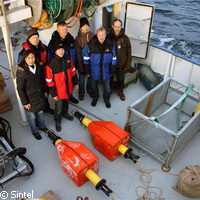Underwater communication made easy
How can scientists monitor what's going on under the sea? For instance, to survey populations of fish in the Arctic, scientists generally gather data manually during expensive research cruises. A team of Norwegian researchers believes that setting up a network of wireless sensors is a much more effective solution. They have tested their concept in the Oslo fjord, and are now ready to take the idea to the next level: Norwegian organisations Kongsberg Maritime and SINTEF will take part in the new EU-funded CLAM ('Collaborative embedded networks for submarine surveillance') and UAN ('Underwater acoustic network) projects, both funded under the EU's Seventh Framework Programme (FP7). 'The whole thing is rather like building a subsea GSM (global system for mobile communications) system,' describes SINTEF scientist Tor Arne Reinen. Last December, a small group of scientists sailed on the Oslofjord; they dropped 5 plastic tubes filled with electronics and batteries into the sea, at regular intervals of several hundred metres. This network of sensor nodes can either be moored or float freely, and the nodes can both send and receive information including temperature, vibration or chemical composition. 'For example, if one of the sensors registers a high concentration of a particular environmental toxin, it could trigger the whole network to monitor just the same chemical,' Dr Reinen suggests. 'This would provide more rapid and reliable mapping of such occurrences than would a single sensor that could only provide the same warning several weeks or months later.' The tests were successful and showed that the nodes worked well together. However, to cover a large area, the network would need hundreds or thousands of units. Even then, the technology would probably be used to focus on specific areas and events. For example, scientists could set up a line of sensors across the migration route of fish species to measure their numbers. Together with several European partners in Italy and the Netherlands, Kongsberg Maritime and SINTEF are embarking on two research projects that will take the technology to the next level, opening up interesting possibilities to monitor pollution levels and watch over critical facilities. The CLAM network is made up of small sensors that can communicate with each other under water at depths of up to 1 500 metres. This new technology could be used for measuring pollution levels, for example. On a different note, the brand new UAN brings together experts from industry, university labs and government agencies. Together, they will further develop and test a system integrating underwater, land and air sensors. In particular, UAN is exploring the possibilities of underwater sound transmission. Such novel technologies should allow a more reliable and responsive monitoring of sensitive infrastructures.
Countries
Norway



